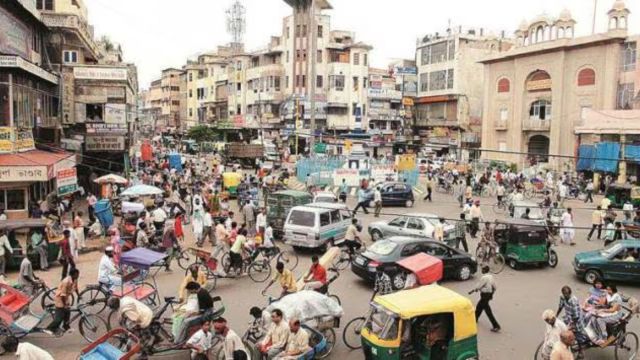Why is the air clean in Delhi’s Chandni Chowk?
A new traffic plan has contributed to improved air quality in Chandni Chowk, a popular tourist destination in Delhi.
 Among the 40 air quality monitoring stations, the one in Chandni Chowk reported cleaner air with an AQI of 186. (File Photo)
Among the 40 air quality monitoring stations, the one in Chandni Chowk reported cleaner air with an AQI of 186. (File Photo)Delhi’s air quality has improved in the last three days, according to data from pollution control boards, but the air remains unhealthy. On Monday at 8 am, Delhi reported an air quality index (AQI) of 273, in the “poor” category, an improvement from the previous day’s AQI of 311, categorised as “very poor”.
Among the 40 air quality monitoring stations, the one in Chandni Chowk reported cleaner air with an AQI of 186, while Nehru Nagar and Shadipur recorded the highest pollution levels, with AQIs of 335 and 320, respectively.
Experts attribute the improved air quality to several factors, including a new traffic plan, as well as topographical and meteorological conditions. Chandni Chowk, a popular tourist destination with high footfall, has managed to lower pollution levels to some extent.
Shashank Jaiswal, the DCP at the traffic headquarters, explained, “This time of the year in Chandni Chowk, we have carried out a comprehensive study of vehicles coming in and out of the area. We have recognised the timings in which polluting heavy vehicles enter the area. Heavy vehicles and vehicles restricted as per GRAP, BS III and BS IV private vehicles are not allowed to enter the area throughout the day. Apart from that, other heavy vehicles enter at regulated times. We have also studied and created different circuits in Chandni Chowk to ensure there is no traffic congestion in any particular area.” Jaiswal also said the joint task force deployed to ensure vehicular norms are followed has contributed to the improvement.
The air quality monitoring station at Chandni Chowk was established by Pune’s Indian Institute of Tropical Meteorology (IITM) in 2014. Dr Sachin D Ghude, senior scientist at the IITM, stated, “The traffic restrictions are one of the main reasons why we are observing better values in Chandni Chowk. Therefore, the contributions due to traffic are slightly lesser in the area. Many visitors are coming to Chandni Chowk, so looking at the exposure, we set up the station. The long-term data we have collected shows that Chandni Chowk usually reports better air quality than other stations. Especially at this time, it is a good example of how an improvement in air quality can be expected if traffic is strictly restricted in localised areas.”
Ghude added that one of the challenges in setting up the station was ensuring that it is not immediately close to the traffic area, as this can yield misleading air quality values. According to the Central Pollution Control Board’s guidelines, air quality monitoring stations need to be situated away from major pollution sources for an accurate representation of air quality levels.
Need for representative air quality data
While traffic restrictions and meteorological factors have helped, experts The Indian Express spoke to emphasised that more needs to be done to obtain better representative air quality data.
Sunil Dahiya, lead environment analyst at Envirocatalysts, a think tank based in Delhi, said, “Many stations are impacted by the local topography of where they are situated, which might lead them not to represent the overall airshed. That is why Chandni Chowk cannot be counted as an exception. For example, the Siri Fort station is situated close to several tall, dense trees, and the green patches can absorb pollution, resulting in the station recording values that are not representative.”
The consensus among experts is that the data being obtained is from stations set up more than a decade ago and that a major revamp in gathering representative air quality data is necessary.
According to Ghude, stations like those at Anand Vihar and ITO are not representative. “Anand Vihar always shows higher values because it is at a traffic intersection. It is a similar scenario with the ITO station. These stations were established around 10-15 years ago, so we need to really consider how to shift the stations to where better representative values can be observed instead of measuring emissions at the source, for which we have other equipment and methods. Efforts should be made to obtain better, more representative air quality data for the city.”
Meanwhile, reduced wind speeds coupled with lower temperatures are expected to aggravate pollution levels, according to the IITM’s bulletin. For the last three days, clear skies and sustained stronger winds from the northwest have enabled the dispersal of pollutants. The stubble-burning season in Punjab and Haryana has ended as of November 30, leading to lower PM2.5 emissions from biomass burning.
“The air quality has dropped in almost all stations, but particulate matter pollution remains above national standards by 2 or 2.5 times and around 14 times above WHO standards. This is still very concerning,” said Dahiya. He added that once temperatures drop and wind speeds pick up, air quality will likely plummet.
The forecast provided by the IITM indicates that the air quality will remain in the “poor” category until Thursday, after which worse pollution levels may be observed, with fluctuations expected between the “very poor” and “poor” categories.







